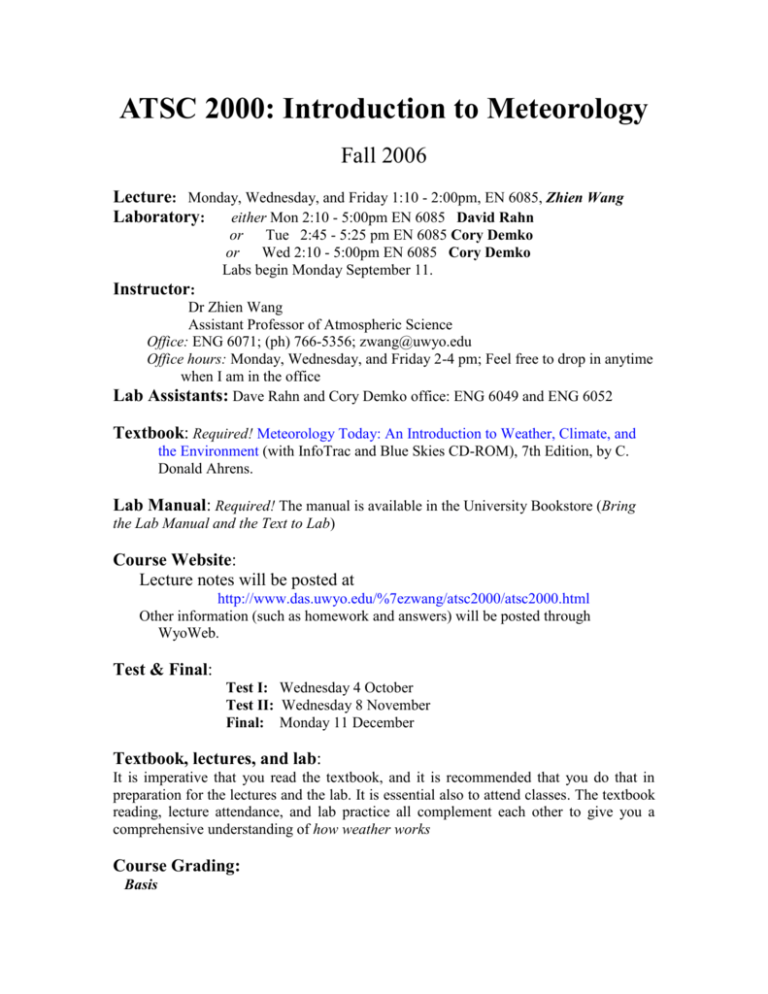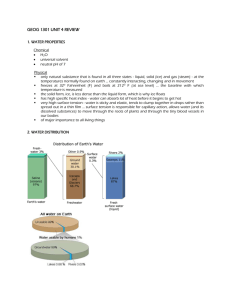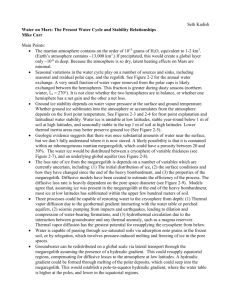ATSC 2000: Introduction to Meteorology
advertisement

ATSC 2000: Introduction to Meteorology Fall 2006 Lecture: Monday, Wednesday, and Friday 1:10 - 2:00pm, EN 6085, Zhien Wang Laboratory: either Mon 2:10 - 5:00pm EN 6085 David Rahn or Tue 2:45 - 5:25 pm EN 6085 Cory Demko or Wed 2:10 - 5:00pm EN 6085 Cory Demko Labs begin Monday September 11. Instructor: Dr Zhien Wang Assistant Professor of Atmospheric Science Office: ENG 6071; (ph) 766-5356; zwang@uwyo.edu Office hours: Monday, Wednesday, and Friday 2-4 pm; Feel free to drop in anytime when I am in the office Lab Assistants: Dave Rahn and Cory Demko office: ENG 6049 and ENG 6052 Textbook: Required! Meteorology Today: An Introduction to Weather, Climate, and the Environment (with InfoTrac and Blue Skies CD-ROM), 7th Edition, by C. Donald Ahrens. Lab Manual: Required! The manual is available in the University Bookstore (Bring the Lab Manual and the Text to Lab) Course Website: Lecture notes will be posted at http://www.das.uwyo.edu/%7ezwang/atsc2000/atsc2000.html Other information (such as homework and answers) will be posted through WyoWeb. Test & Final: Test I: Wednesday 4 October Test II: Wednesday 8 November Final: Monday 11 December Textbook, lectures, and lab: It is imperative that you read the textbook, and it is recommended that you do that in preparation for the lectures and the lab. It is essential also to attend classes. The textbook reading, lecture attendance, and lab practice all complement each other to give you a comprehensive understanding of how weather works Course Grading: Basis Test I 15 % Test II 15 % Final exam 25 % Class participation 5 % Take-home assignments (weekly) 15 % Lab exercises 25 % Scale A: >85% B: 73-85% C: 60-73% D: 50-60% F: <50% I: unfinished labs/homeworks/tests Please arrange your schedule so that you do not miss any of the tests Make-up examinations will only be permitted for students with an officially authorized absence. This includes the final. If you have a valid excuse to explain why you cannot attend an exam, eg, documented illness, court appearance, participation in an official UW sports event, please present it to me as soon as possible Please see me immediately if you are a University athlete likely to be required to be frequently absent from either regular class meetings or examinations Lab attendance is mandatory In order to pass the class, you must achieve a passing grade in the lab Course Outlines: Introduction and Ch. 1 1) Why university science class? 2) Why meteorology? 3) Layers of the atmosphere characterized by temperature, altitude, pressure - exosphere, thermosphere, mesosphere, stratosphere, troposphere 4) Current composition of the earth's atmosphere - permanent gases, variable gases 5) Evolution of the earth's atmosphere - removal of CO2, rise of oxygen 6) Behavior of air - Ideal gas law relating temperature, pressure, density 7) Brief history of meteorology. Ch. 2 - Energy - Topics 1) Energy a) Potential b) Kinetic c) Radiant d) Internal 2) Specific heat - Climate influences 3) Latent heat 4) Heat transfer a) Conduction b) Convection c) Radiation 5) Radiation a) E&M spectrum b) Stefan Boltzmann law – E = σ T4 c) Wien's law – λ = Const/T = 3000 (µm-K) / T d) Planetary equilibrium temperature e) Absorption = Emission (Kirchoff's law) f) Greenhouse effect Ch. 3 – Seasonal and Daily Temperatures - Topics 1) Local temperature controls a) seasons b) location (latitude, altitude, proximity of water) c) humidity d) ventilation (wind chill) Ch. 4 – Light, color, and atmospheric optics - Topics 1) Reflection 2) Refraction 3) Scattering - (Rayleigh, Mie) 4) Diffraction 5) Dispersion 6) Phenomena explained a) blue sky b) white clouds c) haze d) sunsets e) red sun f) twinkling stars g) mirages h) rainbows i) haloes j) sun dogs k) ice pillars Ch. 5 – Atmospheric moisture - Topics 1) What is in a cloud? 2) Water vapor in the air/atmosphere - Definitions a) Vapor pressure b) Saturation vapor pressure c) Relative humidity d) Boiling point (demo – in specially designed flask boil water. Cork with stopper including a thermometer. Turn off invert add ice. Keep water boiling till near room temperature. Estimate air pressure in cooled flask. ) e) Dew point Ch. 6 – Condensation: Dew, fog, and clouds - Topics 1) Condensation a) Dew/Frost b) Nucleation - cloud condensation nuclei c) Fog d) Clouds 2) Cloud classification a) Low b) Middle c) High d) Vertically developed Ch. 7 Stability and cloud development - Topics 1) Thermodynamic diagram a) Lapse rates i) dry adiabatic ii) moist adiabatic iii) environmental iv) water vapor mixing ratio v) lifted condensation level 2) Environmental stability a) Stable b) Neutral c) Conditionally unstable d) Absolutely unstable 3) Causes of instability a) Cold air advection aloft b) Surface warming a) Lifting mechanisms i) orography ii) cold fronts iii) surface heating Ch. 8 – Precipitation - Topics a) Cloud drops to rain drops b) Warm rain processes (collision - coalescence) c) Ice crystal process i) Ice nucleation, ice nuclei ii) Growth by vapor diffusion over ice iii) Ice crystal shapes = f(T) iv) Cloud seeding Ch. 9 – The atmosphere in motion: Air pressure, forces, and winds - Topics 1) Laws of motion: Force(F),mass (m), acceleration(a), F=ma 2) Forces that affect air motion a) Gravity b) Pressure gradient force i) Differential heating of the earth Equator to pole pressure gradient c) Coriolis force i) Coordinate systems - frames of reference d) Friction 3) Force balance a) Hydrostatic b) Geostrophic i) Upper level westerlies ii) Cyclonic / Anticyclonic circulation iii) Thermal wind c) Gradient – hurricanes Ch. 10 – Wind: Small-scale and local systems – Topics 1) Small-scale winds a) Scales of motions b) Eddies 2) Local wind systems a) Sea and land breezes b) Chinooks Ch. 11 – Wind: Global systems - Topics 1) General atmospheric circulation a) Differential heating of earth's surface b) Three cell model (Hadley, Ferrel, Polar) i) Inter Tropical Convergence Zone (ITCZ) ii) Subsidence - deserts iii) Trade winds iv) Cell boundaries c) Upper level westerlies, i) jet streams ii) wave structure 2) General oceanic circulation a) Ekman spiral - upwelling b) Gulf stream c) El Nino Southern Oscillation Ch. 12 - Air masses and fronts - Topics 1) Air mass definition/ source regions 2) Air mass types and source regions in our area a) cP continental Polar - central Canada b) cT continental Tropical - central Mexico c) mP maritime Polar - northern Pacific d) mT maritime Tropical - central eastern Pacific/ gulf of Mexico e) cA continental Arctic 3) Fronts a) Cold b) Warm c) Occluded d) Stationary Ch. 13 Middle latitude cyclones - Topics 1) Polar front theory 2) Cyclones as eddies in large scale flow - transporting energy 3) Upper level waves a) Genesis - vorticity b) Long c) Short 4) Vertical structure of cyclone/anticyclone a) Upper level and low level divergence/convergence b) Relationship of cyclones, jet stream, upper level trough. 5) Life cycle of extratropical cyclone a) Cyclogenesis b) Development c) Maturity d) Decay Ch. 14 Weather forecasting - Topics 1) Origin - Richardson 1922 2) Steps in numerical prediction a) Observations - model initialization i) surface ii) upper air iii) radar iv) satellite v) aircraft b) Data assimilation - model grid space/initialization c) Types of models d) Forecasts e) Problems with forecasts f) Natural limits Ch. 15 – Thunderstorms and tornadoes - Topics 1) Convection a) Showers b) Thunderstorms c) Tornadoes Ch. 16 – Hurricanes - Topics 1) Description 2) Formation (tropical storm stages) and dissipation Ch. 17 – Air pollution (Human influences on the atmosphere) - Topics 1) Ozone depletion 2) Air pollution – smog 3) Acid rain Ch 18 – Global Climate- Topics Present climates a) Climate controls b) Climate classifications for the world i) Western hemisphere ii) Eastern hemisphere Ch. 19 Climate change - Topics 1) Determining past climates a) Millions of years - geologic evidence b) Up to 400,000 years ago - ice cores c) ~ 5000 years - historical crop records d) 500-1000 years - dendrochronology 2) Climate history a) 700 Mya - last ice age ~ 20,000 Ya, Ya=Years ago b) 20,000 - 1,000 Ya c) Last 1000 years 3) Causes of climate change a) Millions of years - geologic activity: plate tectonics, sea floor spreading, mountain building. b) Thousands of years - Milankovitch theory i) Eccentricity (100,000 years) ii) Nutation (41,000 years) - changes in earth's tilt iii) Precession (23,000 years) - change in direction earth's axis points c) Decadal i) Volcanism - asteroid impacts ii) Sunspot cycle - Maunder minimum 1645-1715 d) Seasonal - long wave pattern e) Anthropogenic i) Increases in carbon dioxide ii) Predictions/uncertainties Lab Schedule Week Beginning: August 28 September 4 September 11 September 18 No labs No labs: Labor Day I: Surface Weather Observations II: Temperature Structure of the Lower Atmosphere (meet in computer lab) September 25 October 2 October 9 October 16 October 23 October 30 November 7 November 13 November 20 November 27 December 4 III: Radiative Energy Transfer IV: The Greenhouse Effect (Take Home Lab) V: Humidity Variables VI: Thermodynamic Diagrams VII: Static Stability and Clouds VIII: Freezing of Water: Ice Nucleation IX: Interpreting Weather-Satellite Images (Take Home Lab) X: Force Balance and Atmospheric Motion No Labs: Thanksgiving XI: Frontal Disturbances. Part I: Surface Charts XII: Frontal Disturbances. Part II: The Jet Stream and Surface Weather







